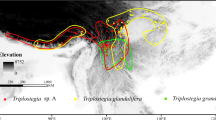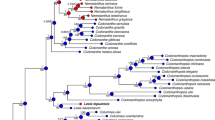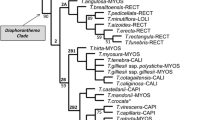Abstract
Decreasing plant size with increasing latitude or altitude is a commonly observed pattern. Among the four genera of the Petasites-clade (Asteraceae–Senecioneae), Petasites and Tussilago, widespread throughout the Northern Hemisphere, mostly have large leaves and many capitula, whereas Homogyne and Endocellion from alpine and arctic environments have much smaller leaves and only one or few capitula. We present a comprehensively sampled and dated phylogeny of Petasites, Endocellion, Homogyne and Tussilago based on nuclear ribosomal ITS and plastid ndhF-rpl32 and rpl32-trnL sequences. The four genera form a well-supported monophyletic group. Endocellion was found to be nested in Petasites, and relationships among the other three genera remain unresolved. Dwarfism with small leaves and a reduced number of capitula evolved five times in arctic–alpine species of this group. Although all dwarf species of the Petasites-clade grow in arctic or alpine habitats, not all species from such habitats are dwarfs. In the European Alps, Homogyne alpina, H. discolor and Petasites paradoxus occur in (sub-)alpine habitats, but only the species of Homogyne are dwarfs with small leaves and only one flowering head, whereas P. paradoxus has much larger leaves and numerous capitula. These species differ in ecology: whereas Homogyne is found in nutrient-poor and stable habitats, P. paradoxus grows in nutrient-rich and often disturbed habitats. We conclude that although decreasing plant size with increasing latitude or altitude is an overall trend in the group, factors such as nutrient availability and/or habitat disturbance can counteract this trend.




Similar content being viewed by others
References
Aeschimann D, Lauber K, Moser DM, Theurillat J-P (2004) Flora Alpina. Haupt, Bern
Barkley TM (2006) Tussilago. In: Flora of North America Editorial Committee (eds) Flora of North America vol. 20, Oxford University Press, New York, p 635
Bayer RJ, Bogle AL, Cherniawsky DM (2006) Petasites. In: Flora of North America Editorial Committee (eds) Flora of North America vol. 20, Oxford University Press, New York, pp 635–640
Billings WD, Mooney HA (1968) The ecology of arctic and alpine plants. Biol Rev 43:481–529
Blattner F (1999) Direct amplification of the entire ITS region from poorly preserved plant material using recombinant PCR. BioTechniques 27:1180–1186
Bliss LC (1971) Arctic and alpine plant life cycles. Annual Rev Ecol Syst 2:405–438
Bogle AL (1968) Evidence for the hybrid origin of Petasites warrenii and P. vitifolius. Rhodora 70:533–551
Bremer K (1994) Asteraceae: cladistics and classification. Timber Press, Portland, Oregon
Chen YL, Nordenstam B, Jeffrey C, Koyama HH, Funston M, Vincent L (2011) Asteraceae tribe Senecioneae. In: Wu ZY, Raven PH, Hong DY (eds) Flora of China vols. 20–21, Science Press, Beijing, and Missouri Botanical Garden Press, St. Louis
Cherniawsky DM, Bayer RJ (1998) Systematics of North American Petasites (Asteraceae: Senecioneae). III. A taxonomic revision. Canad J Botany 76:2061–2075. doi:10.1139/b98-151
Dingwall I (1976) Petasites. In: Tutin TG, Heywood VH, Burges NA, Moore DM, Valentine DH, Walter SM, Webb DA (eds) Flora Europaea, vol 4. Cambridge University Press, Cambridge, pp 186–188
Drummond AJ, Rambaut A (2007) BEAST: bayesian evolutionary analysis by sampling trees. BMC Evol Biol 7:214. doi:10.1186/1471-2148-7-214
Ellenberg H (1996) Vegetation Mitteleuropas mit den Alpen in ökologischer, dynamischer und historischer Sicht, 5th edn. Ulmer, Stuttgart
Fischer MA, Oswald K, Adler W (2008) Exkursionsflora für Österreich, Liechtenstein, Südtirol, 3rd edn. Biologiezentrum der Oberösterreichischen Landesmuseen, Linz
Hegi G (1929) Illustrierte Flora von Mitteleuropa. Mit besonderer Berücksichtigung von Deutschland, Oesterreich und der Schweiz. Zum Gebrauche in den Schulen und zum Selbstunterricht, VI. Band, 2. Hälfte. Lehmanns Verlag, München
Hind N, Kay J (2006) A nature print of Petasites japonicus subsp. giganteus. Curtis's Bot Mag 23:325–341. doi:10.1111/j.1467-8748.2006.00547.x
Huelsenbeck JP, Ronquist F (2001) MrBayes: bayesian inference of phylogeny. Bioinformatics 17:754–755
Johnson PL (1969) Arctic plants, ecosystems and strategies. Arctic 22:341–355
Kay K, Whittall J, Hodges S (2006) A survey of nuclear ribosomal internal transcribed spacer substitution rates across angiosperms: an approximate molecular clock with life history effects. BMC Evol Biol 6:36. doi:10.1186/1471-2148-6-36
Kimura M (1980) A simple method for estimating evolutionary rate of base substitutions through comparative studies of nucleotide sequences. J Molec Evol 16:111–120
Kokubugata G, Nakamura K, Shinohara W, Saito Y, Peng C-I, Yokota M (2010) Evidence of three parallel evolutions of leaf dwarfism and phytogeography in Lysimachia sect. Nummularia in Japan and Taiwan. Molec Phylogen Evol 54:657–663. doi:10.1016/j.ympev.2009.09.004
Körner C (1999) Alpine plant life. Functional plant ecology of high mountain ecosystems, 2nd edn. Springer, Berlin
Körner C, Larcher W (1988) Plant life in cold climates. Plants and temperature. In: Long SF, Woodward FI (eds) Symposia of the Society for Experimental Biology, vol 42. The Company of Biologists Ltd, Cambridge, pp 25–57
Körner C, Neumayer M, Menendez-Riedl SP, Smeets-Scheel A (1989) Functional morphology of mountain plants. Flora 182:353–383
Kuprianova LA (2000) Genera Tussilago, Petasites, Nardosmia, Homogyne. In: Schischkin BK, Bobrov EG (eds) Flora of the USSR vol. 26, Smithsonian Institution Libraries, Washington, pp 609–624
Landolt E, Bäumler B, Erhardt A, Hegg O, Klötzli F, Lämmler W, Nobis M, Rudmann-Maurer K, Schweingruber FH, Theurillat J-P, Urmi E, Vust M, Wohlgemuth T (2010) Flora indicativa: Ökologische Zeigerwerte und biologische Kennzeichen zur Flora der Schweiz und der Alpen. Haupt, Bern
Lanfear R, Calcott R, Ho SYW, Guindon S (2012) PartitionFinder: combined selection of partitioning schemes and substitution models for phylogenetic analyses. Molec Biol Evol 29:1695–1701. doi:10.1093/molbev/mss020
Liu S, Illarionova ID (2011) Asteraceae tribe Senecioneae. In: Wu ZY, Raven PH, Hong DY (eds) Flora of China vols. 20–21, Science Press, Beijing, and Missouri Botanical Garden Press, St. Louis
Maddison DR, Maddison WP (2000) MacClade 4.0: analysis of phylogeny and character evolution. Sinauer Assoc., Sunderland
Maddison WP, Maddison DR (2006) StochChar: a package of Mesquite modules for stochastic models of character evolution. Version 1.1
Maddison WP, Maddison DR (2011) Mesquite: a modular system for evolutionary analysis. Version 2.75. Available at: http://mesquiteproject.org. Accessed 14 March 2013
Merxmüller H (1952) Untersuchungen zur Sippengliederung und Arealbildung in den Alpen. Teil 1. Jahrb Vereins Schutze Alpenpfl 17:96–133
Meusel H, Jäger E (1992) Vergleichende Chorologie der zentraleuropäischen Flora, vol 3. Fischer, Jena
Miller MA, Pfeiffer W, Schwartz T (2010) Creating the CIPRES Science Gateway for inference of large phylogenetic trees. In: Proceedings of the gateway computing environments workshop (GCE), 14 Nov. 2010, New Orleans, pp 1–8
Muir G, Fleming CC, Schlötterer C (2001) Three divergent rDNA clusters predate the species divergence in Quercus petraea (Matt.) Liebl. and Quercus robur L. Molec Biol Evol 18:112–119
Nordenstam B (2007) Tribe Senecioneae. In: Kubitzki K, Kadereit JW, Jeffrey C (eds) The families and genera of vascular plants, vol 8. Springer, Berlin, pp 208–241
Ordoñez JC, van Bodegom PM, Witte J-PM, Wright IJ, Reich PB, Aerts R (2009) A global study of relationships between leaf traits, climate and soil measures of nutrient fertility. Global Ecol Biogeogr 18:137–149. doi:10.1111/j.1466-8238.2008.00441.x
Ozenda P (1988) Die Vegetation der Alpen im europäischen Gebirgsraum. Fischer, Stuttgart
Pelser PB, Nordenstam B, Kadereit JW, Watson LE (2007) An ITS phylogeny of tribe Senecioneae (Asteraceae) and a new delimitation of Senecio L. Taxon 56:1077–1104
Pfeiffer T, Günzel C, Frey W (2008) Clonal reproduction, vegetative multiplication and habitat colonisation in Tussilago farfara (Asteraceae): a combined morpho-ecological and molecular study. Flora 203:281–291. doi:10.1016/j.flora.2007.02.008
Pirie MD, Humphreys AM, Galley C, Barker NP, Verboom GA, Orlovich D, Draffin SJ, Lloyd K, Baeza CM, Negritto M, Ruiz E, Cota Sanchez JH, Reimer E, Linder HP (2008) A novel supermatrix approach improves resolution of phylogenetic relationships in a comprehensive sample of danthonioid grasses. Molec Phylogen Evol 48:1106–1119. doi:10.1016/j.ympev.2008.05.030
Polunin N (1959) Circumpolar arctic flora. Oxford University Press, Oxford
Rambaut A, Drummond AJ (2007) Tracer, version 1.5. MCMC Trace File Analyser. Computer program and documentation distributed by the authors. Available at: http://beast.bio.ed.ac.uk/Tracer. Accessed 22 Nov 2012
Rambaut A, Drummond AJ (2009) TreeAnnotator, version 1.5.4. Available at: http://beast.bio.ed.ac.uk/TreeAnnotator. Accessed 23 Nov 2015
Rodríguez F, Oliver JL, Marín A, Medina JR (1990) The general stochastic model of nucleotide substitution. J Theoret Biol 42:485–501. doi:10.1016/S0022-5193(05)80104-3
Shaw J, Lickey EB, Schilling EE, Smith RL (2007) Comparison of whole chloroplast genome sequences to choose noncoding regions for phylogenetic studies in angiosperms: the tortoise and the hare III. Amer J Bot 94:275–288. doi:10.3732/ajb.94.3.275
Shinohara W, Murakami N (2006) How have the alpine dwarf plants in Yakushima been miniaturized? A comparative study of two alpine dwarf species in Yakushima, Blechnum nipponicum (Blechnaceae) and Lysimachia japonica (Primulaceae). J Pl Res 119:571–580. doi:10.1007/s10265-006-0016-5
Simmons MP, Ochoterena H (2000) Gaps as characters in sequence-based phylogenetic analyses. Syst Biol 49:369–381
Stamatakis A, Hoover P, Rougemont J (2008) A rapid bootstrap algorithm for the RAxML web-servers. Syst Biol 75:758–771. doi:10.1080/10635150802429642
Swofford DL (2002) PAUP*: Phylogenetic analysis using parsimony (*and other methods), version 4.0. Sinauer, Sunderland, Massachusetts
Tamura K, Nei M (1993) Estimation of the number of nucleotide substitutions in the control region of mitochondrial DNA in humans and chimpanzees. Molec Biol Evol 10:512–526
Tkach NV, Hoffmann MH, Röser M, Korobkov AA, von Hagen KB (2008) Parallel evolutionary patterns in multiple lineages of arctic Artemisia L. (Asteraceae). Evolution 62:184–198. doi:10.1111/j.1558-5646.2007.00270.x
Toman J (1972) A taxonomic survey of the genera Petasites and Endocellion. Folia Geobot Phytotax 7:381–406
Troll W (1939) Vergleichende Morphologie der höheren Pflanzen vol. 1(1), Vegetationsorgane. Borntraeger, Berlin
Turesson G (1925) The plant species in relation to habitat and climate. Hereditas (Lund) 6:147–236
Turesson G (1930) The selective effect of climate upon the plant species. Hereditas (Lund) 14:99–152
Tutin TG (1976a) Homogyne. In: Tutin TG, Heywood VH, Burges NA, Moore DM, Valentine DH, Walter SM, Webb DA (eds) Flora Europaea, vol 4. Cambridge University Press, Cambridge, pp 188–189
Tutin TG (1976b) Tussilago. In: Tutin TG, Heywood VH, Burges NA, Moore DM, Valentine DH, Walter SM, Webb DA (eds) Flora Europaea, vol 4. Cambridge University Press, Cambridge, p 186
Vierhapper F (1923) Über Verwandtschaft und Herkunft der Gattungen Homogyne und Adenostyles. Österr Bot Z 73:150–164
Wendel JF, Doyle JJ (1998) Phylogenetic incongruence: window into genome history and molecular evolution. In: Soltis DE, Soltis P, Doyle JJ (eds) Molecular systematics of plants II. Kluwer Academic Publishers, Boston, pp 265–296
White TJ, Bruns T, Lee S, Taylor J (1990) Amplification and direct sequencing of fungal ribosomal RNA genes for phylogenetics. In: Innis MA, Gelfand DH, Sninsky JJ, White TJ (eds) PCR protocols: a guide to methods and applications. Academic Press, San Diego, pp 315–322
Zhang M-L, Uhink CH, Kadereit JW (2007) Phylogeny and biogeography of Epimedium/Vancouveria (Berberidaceae): western North American—East Asian disjunctions, the origin of European mountain plant taxa, and East Asian species diversity. Syst Bot 32:81–92. doi:10.1600/036364407780360265
Acknowledgments
We are grateful to the curators of the following herbaria for permission to take leaf material for DNA analysis: B, HAST, M, O, PE, PGFA, PMR, VLA and WU. E. Boyko (Vladivostok) is acknowledged for kindly donating herbarium specimens and providing information. We thank D. Franke and M. Geyer (both Mainz) for help with the illustrations and A.J. Moore (Providence) for helpful comments on an earlier version of the manuscript. Two anonymous reviewers are gratefully acknowledged for helpful comments.
Author information
Authors and Affiliations
Corresponding author
Ethics declarations
Conflict of interest
The authors declare that they have no conflict of interest.
Additional information
Handling editor: Marcus Koch.
Information on Electronic Supplementary Material
Below is the link to the electronic supplementary material.
Information on Electronic Supplementary Material
Information on Electronic Supplementary Material
Online Resource 1. The alignments of the different markers.
Online Resource 2. Maximum likelihood tree obtained with RAxML of the nuclear ITS data set.
Online Resource 3. Maximum likelihood tree obtained with RAxML of the plastid ndhF-rpl32-trnL data set.
Rights and permissions
About this article
Cite this article
Steffen, S., Dillenberger, M.S. & Kadereit, J.W. Of dwarfs and giants: phylogeny of the Petasites-clade (Asteraceae–Senecioneae) and evolution of miniaturization in arctic–alpine environments. Plant Syst Evol 302, 545–559 (2016). https://doi.org/10.1007/s00606-016-1282-x
Received:
Accepted:
Published:
Issue Date:
DOI: https://doi.org/10.1007/s00606-016-1282-x




